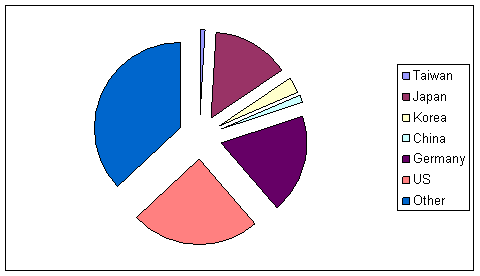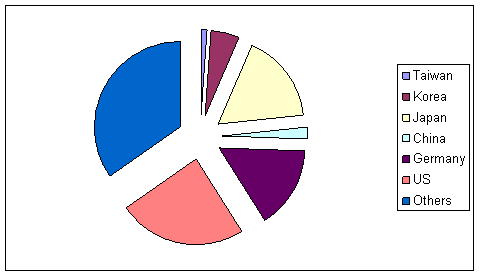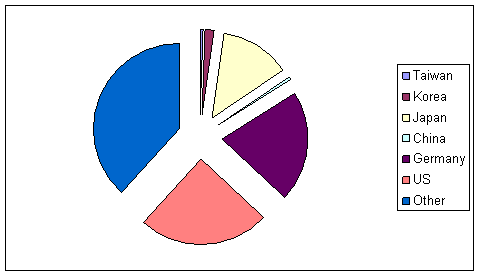中文摘要
专利常被视为创新发明及市场领导力的强大指标。量化一国的创新动力,多以所申请的专利数量计算。申请量不光是一国运用知识能力的指针,也展现国家将知识转换成潜在经济成就的能力。本文将台湾地区和韩、日、中 等亚洲三国,及亚洲各国的主要对手德国与美国共六个地区,2009年个别在EPO的专利申请量作出统计与分析。以每百万人中有多少件专利申请量计算,德国拔得头筹,胜过第二名日本两倍,美国则位居第三。韩国人口是台湾两倍,每百万人专利申请量也是台湾的两倍。中国有世界最庞大的人口,每百万人专利申请量却远远落后其它国家。但她正投入大量资金研发,未来五年内可望在申请量上巨幅上升,不容小觑。
Introduction
It has often been said that intellectual property rights and specifically patents are a strong indicator of innovation, inventions and market leadership. Applying for a patent opens up the invention to the public, but simultaneously it gives protection.
One way of quantifying a country's inventive drive is by counting the number of patents it applies for. Not only does the number give an indication of its ability to utilize knowledge, but it also shows its ability to translate its knowledge into potential economic achievements. This article aims at providing an indication of the inventive strengths of the major Asian players, the United States, and Germany as far as their patent applications for 2009 at the European Patent Office (EPO) are concerned.
Number of Applications
Firstly, we wanted to get a broad perspective of the total applications filed by each of the selected countries with the EPO.
The US represents nearly a quarter of all applications filed with the EPO during 2009. Second is Europe's biggest economy, Germany, with 18.6% of the applications. Japan, traditionally a leading applicant is third with 14.8%.
Korea, China and Taiwan follow with smaller percentages.
However, keep in mind that these percentages represent filings for 2009. It is expected that the number of filings received from China will continue to increase rapidly in the next few years. Chinese academics are encouraged and funded by government to file patents in order to drive innovation. In addition, companies are rewarded with cash bonuses and tax breaks for generating patents.
China's R&D/GDP ratio more than doubled, from 0.6% in 1996 to 1.5% in 2007, a period during which China's GDP grew at 12% annually(National Science and Engineering Board: Science and Engineering Indicators 2010)—an enormous, sustained increase. The gap in China's R&D/GDP ratio relative to those of developed economies suggests that China's R&D volume can continue to grow rapidly.
According to Su Hsing Loh in "The World Today: China New Incentives?", China plans to allocate 2.2% of its GDP to research and development within the next 5 years. Furthermore, Su also reported that China aims at reaching two million annual patent filings per year by 2015.
|
Taiwan |
Japan |
Korea |
China |
Germany |
US |
Other |
Total |
Number of EPO applications filed in 2009 |
1006 |
19933 |
4193 |
1631 |
25107 |
32966 |
49706 |
134542 |
Percentage of total |
0.75 |
14.8 |
3.1 |
1.2 |
18.6 |
24.5 |
36.9 |
|

Application by technical fields
Since Taiwan is a leading exporter of computer chips, LCD panels, DRAM computer memory devices, networking devices, and consumer electronics, this section specifically distinguishes between patents filed in the Hi-tech fields (including patents relating to electricity and semiconductors, handling and processing, audio and video and media, electronics, computers, telecommunications) and those who do not relate to Hi-tech industries.
Hi-tech
|
Taiwan |
Japan |
Korea |
China |
Germany |
US |
Others |
Total in EU |
Number of EPO applications filed in 2009 |
631 |
9104 |
2676 |
1096 |
8237 |
12722 |
18415 |
52881 |
Percentage of total |
1.2 |
17.2 |
5 |
2 |
15.6 |
24 |
34.8 |
|

Other non Hi-tech applications
|
Taiwan |
Japan |
Korea |
China |
Germany |
US |
Other |
Total in EU |
Number of EPO applications filed in 2009 |
375 |
10829 |
1517 |
535 |
16870 |
20244 |
31291 |
81661 |
Percentage of total |
0.5 |
13.3 |
1.8 |
0.65 |
20.65 |
24.7 |
38.3 |
|

As expected, Taiwan's share of the total number of Hi-tech patents filed at the EPO is much higher than its total share of patents filed at the EPO.
The same trend can be observed for Japan, Korea, and China – all of whom are also Hi-tech oriented economies.
Germany's contribution to the total number of Hi-tech patents is less than its contribution to other technical fields and the US have made more-or-less equal contributions to both Hi-tech and non Hi-tech (percentage wise).
The fact that the US and Germany, respectively the biggest and second biggest contributors to EPO patents, lean over to non Hi-tech patents, might be indicative of their traditional industries. On the other hand, given the rapid pace of technological development coupled with the rate at which competitors are able to imitate and bring those technologies to the market, it is perhaps not unexpected that many businesses opt for investing in continued innovation rather than spend time and resources to protect products that possibly will be imitated and become old-fashioned soon.
Inventive capacity in relative terms
Finally, to get a more real feeling of inventive drive of each of the listed countries within the scope of the EPO, we have decided to express the number of patents filed at the EPO relative to the population.
In relative terms, Germany outranks its nearest competitor, Japan, by double the amount of patents per million. The leading applicant in the EPO, the US, falls to a third place.
Korea, with double the size of Taiwan's population, also seems to be filing double the amount of patents per million people.
China, having the largest population on earth, falls far behind when it comes to patenting per million people. However, as mentioned above, China is spending vast amounts of money on R&D, hence a steep rise in the number of applications from China can be expected in the course of the next five years.
|
Taiwan |
Korea |
Japan |
China |
Germany |
US |
Population estimate 2009 (million) |
23 |
48 |
127 |
1339 |
81 |
311 |
Number of EPO applications filed in 2009 |
1006 |
4193 |
19933 |
1631 |
25107 |
32966 |
Patents per million people |
43.7 |
87.3 |
156.9 |
1.2 |
309.9 |
106 |
Conclusion
The above comparisons relate only to patents filed with the EPO. The number of patents granted to the respective countries was not considered. It is thus a purely quantitative rather than qualitative enquiry.
Nevertheless, these numbers should be indicative of some measure of competitiveness in the European market.
Sources
1) National Science and Engineering Board: Science and Engineering Indicators 2010
http://www.nsf.gov/statistics/seind10/c0/c0s2.htm
2) The World Today – China: New Incentives?
http://www.chathamhouse.org.uk/publications/twt/archive/view/-/id/2161/
3) The IPKat – Why do Chinese academics file so many patents
http://ipkitten.blogspot.com/2011/02/why-do-chinese-academics-file-so-many.html
|